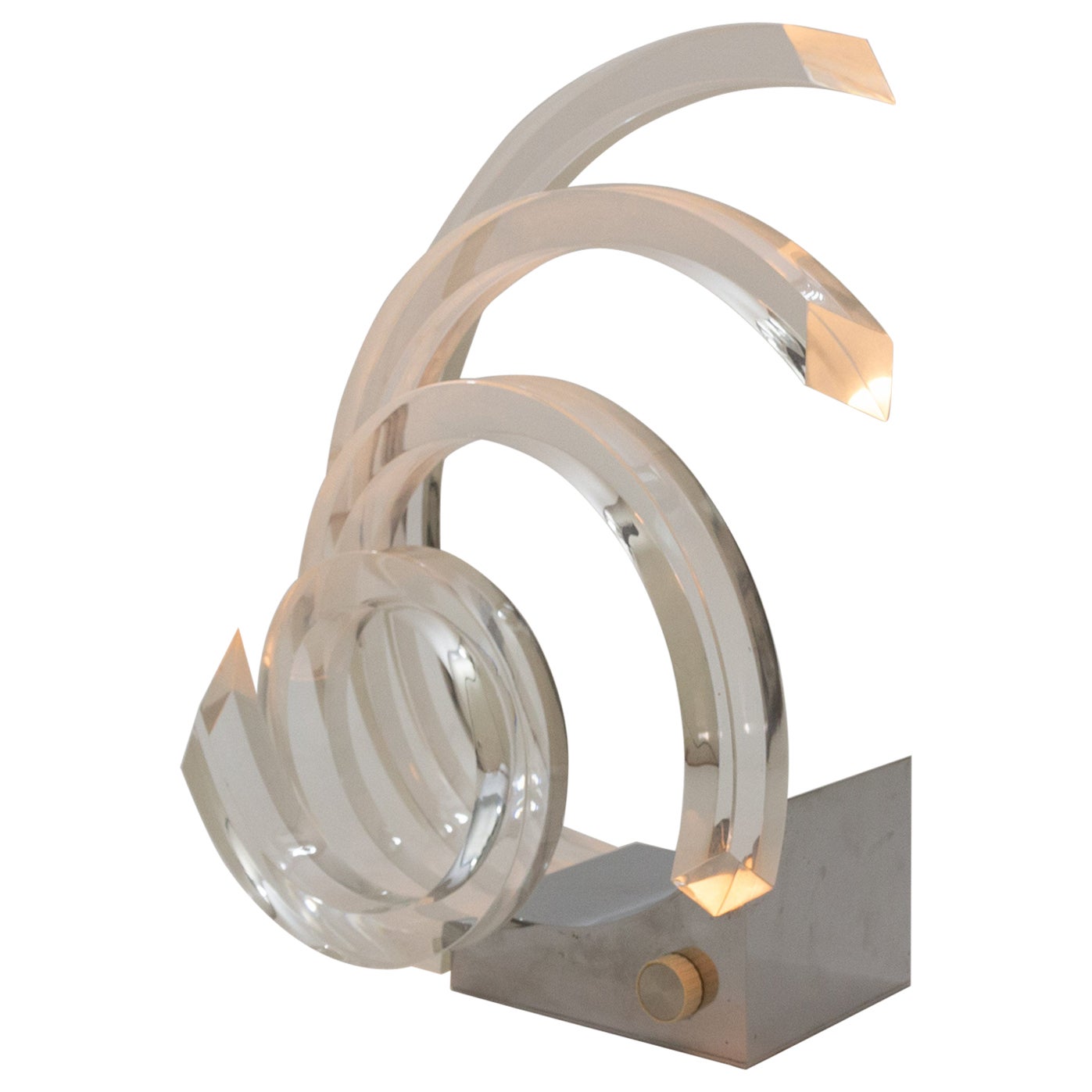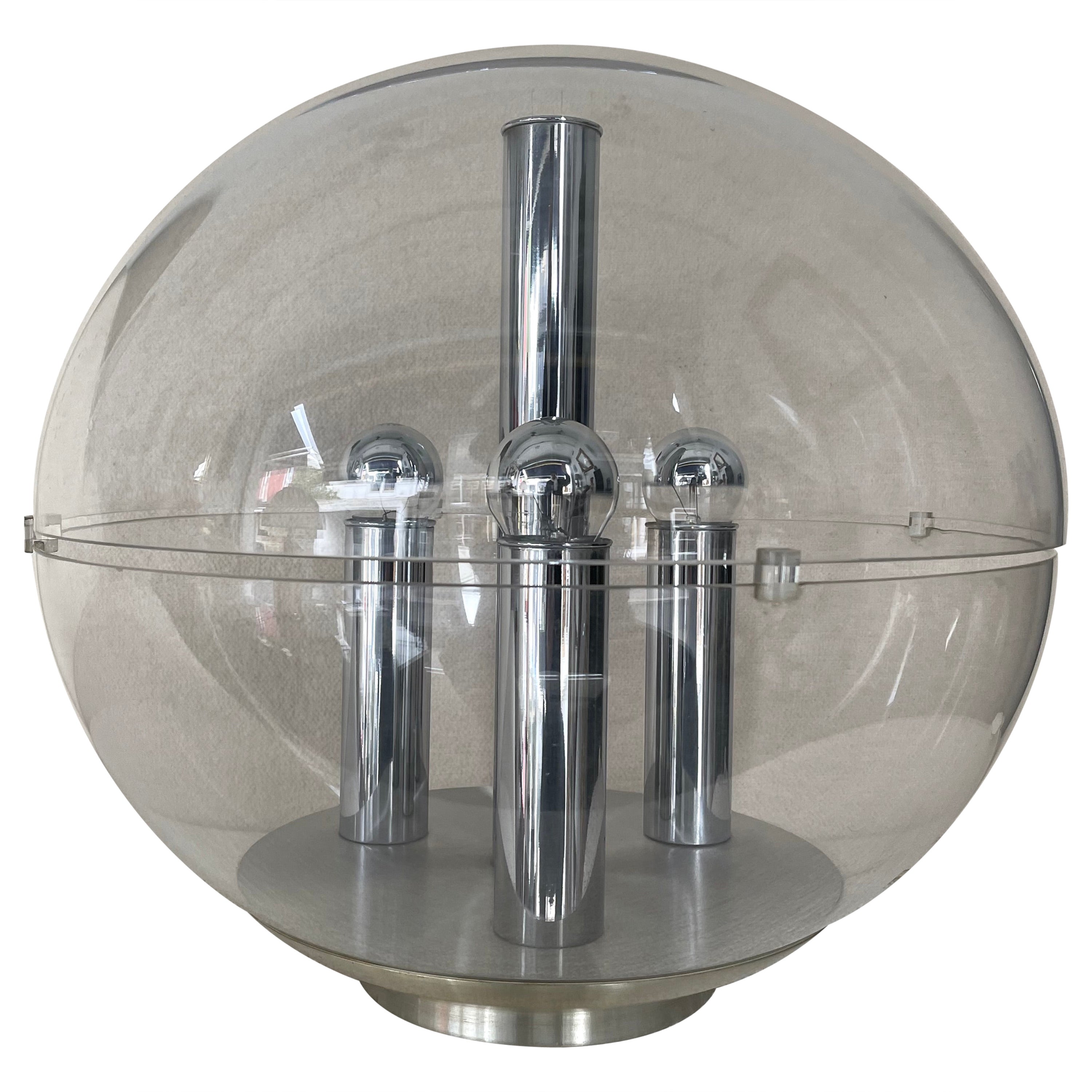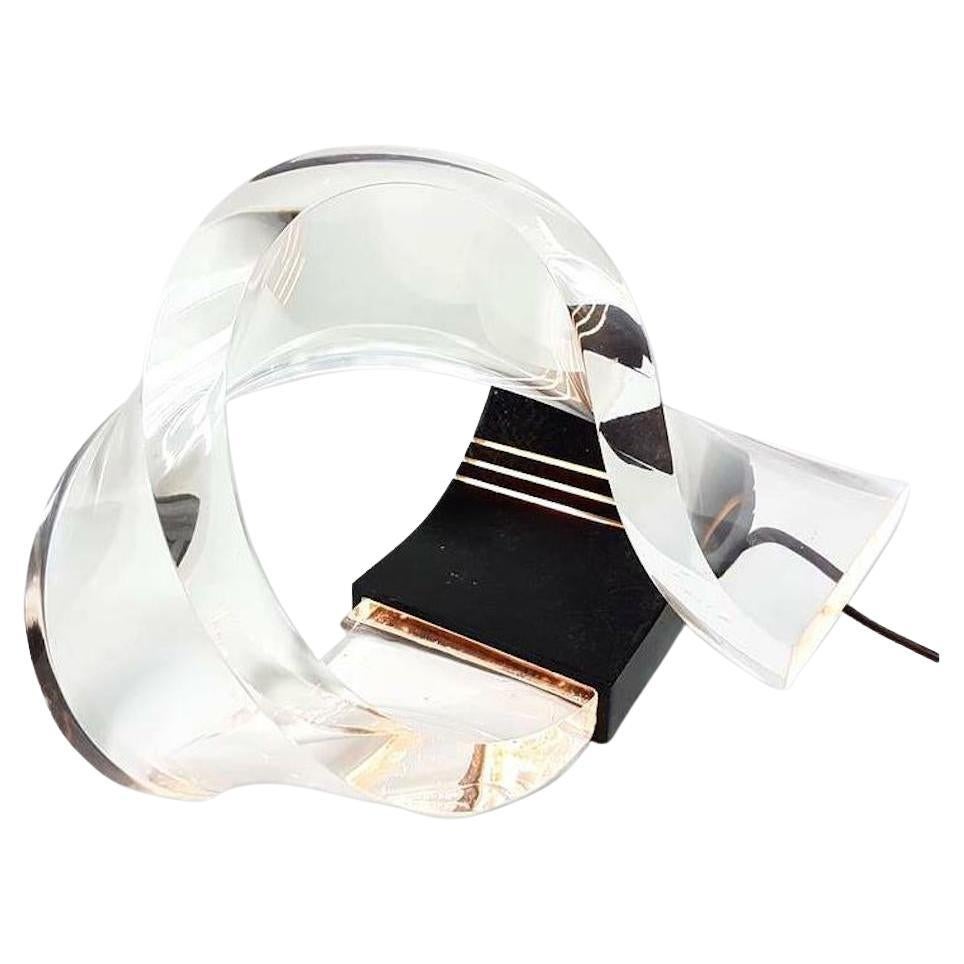Items Similar to Space Age Lucite and Metal Sculpture Lamp by Gaetano Missaglia, Italy, 1970s
Want more images or videos?
Request additional images or videos from the seller
1 of 9
Space Age Lucite and Metal Sculpture Lamp by Gaetano Missaglia, Italy, 1970s
About the Item
The Italian Space Age acrylic glass sculptural lamp by Gaetano Missaglia, from the 1970s, is a stunning piece of lighting design that captures the essence of the Space Age era. Created by the celebrated Italian designer, Gaetano Missaglia, this lamp is a true work of art that seamlessly combines form and function.
Crafted from high-quality acrylic glass, the lamp features a sculptural form that is both dynamic and mesmerizing. Its translucent surface creates a warm and inviting glow, which is amplified by the lamp's unique shape and structure.
The lamp's sculptural shade is intricately formed, evoking the sense of movement and energy associated with the Space Age era.
As a functional piece of lighting, the Italian Space Age acrylic glass sculptural lamp is ideal for use in a variety of settings, from a living room or bedroom to a home office or studio. Its sculptural form creates a striking focal point, while its warm glow adds a sense of ambiance and tranquility to any space.
Overall, the Italian Space Age acrylic glass sculptural lamp by Gaetano Missaglia from the 1970s is a stunning example of lighting design. Its unique combination of sculptural form and functional lighting makes it a highly sought-after piece for collectors and design enthusiasts alike.
- Creator:Gaetano Missaglia (Designer)
- Dimensions:Height: 15.36 in (39 cm)Diameter: 18.9 in (48 cm)
- Power Source:Plug-in
- Lampshade:Included
- Style:Space Age (Of the Period)
- Materials and Techniques:
- Place of Origin:
- Period:
- Date of Manufacture:1970
- Condition:
- Seller Location:Melbourne, AU
- Reference Number:1stDibs: LU2201334086582
About the Seller
4.0
Vetted Seller
These experienced sellers undergo a comprehensive evaluation by our team of in-house experts.
Established in 2015
1stDibs seller since 2016
29 sales on 1stDibs
Typical response time: 20 hours
- ShippingRetrieving quote...Ships From: Campbellfield, Australia
- Return PolicyThis item cannot be returned.
More From This SellerView All
- Cubic Chandelier 37 Lights by Gaetano Sciolari, Italy, 1970sBy Gaetano SciolariLocated in Melbourne, VICMid-Century Modern Cubic chandelier designed by Gaetano Sciolari. This pendant consists of 37 rectangular polished chrome cubes with textured lucite shades. The hanging chain can be adjusted to suit, and the original ceiling cap is included. Labelled on inside of ceiling cap - Cubic by Lightolier, Made in Italy. The Cubic light...Category
Vintage 1970s Italian Mid-Century Modern Chandeliers and Pendants
MaterialsAluminum, Chrome
- Asteroid Lamp by Ettore Sottsass for Poltronova, Italy, 1968By Ettore Sottsass, PoltronovaLocated in Melbourne, VICThe Asteroid Lamp is indeed a remarkable piece of design created by Ettore Sottsass in 1968. Ettore Sottsass was a prominent Italian designer and archite...Category
20th Century Italian Table Lamps
MaterialsMetal
- Micol" Table Lamp by Sergio Mazza and Giuliana Gramigna for QuattrifolioBy Sergio Mazza, QuattrifolioLocated in Melbourne, VICTable lamp designed by Sergio Mazza & Giuliana Gramigna, 1971. White hand blown Murano glass shade supported by enameled metal base.Category
Mid-20th Century Italian Mid-Century Modern Table Lamps
MaterialsMurano Glass
- Gabriella Crespi Large Fungo Table Lamp, Rising Sun Series, 1973, ItalyBy Gabriella CrespiLocated in Melbourne, VICLarge and striking 'Fungo' table lamp from the iconic Rising Sun Series with lacquered bamboo and polished brass dome shade and elegant flared brass base in a gold finish, Italy, 197...Category
20th Century Italian Table Lamps
MaterialsBrass
- Artona Sideboard by Afra & Tobia Scarpa for Maxalto, Italy, 1970sBy Afra & Tobia ScarpaLocated in Melbourne, VICThe Artona sideboard by Afra and Tobia Scarpa, produced by Maxalto in the 1970s, is a classic piece of furniture that exemplifies the elegant simplici...Category
Vintage 1970s Italian Mid-Century Modern Sideboards
MaterialsLeather, Walnut
- Ennio Chiggio 'Environ One' Sofa for Nikol International, Italy, 1970sBy Ennio ChiggioLocated in Melbourne, VICThe Environ One Sofa by Ennio Chiggio for Nikol International, 1970, is a rare vintage piece of furniture that exemplifies the best of Mid-Century Modern desi...Category
Vintage 1970s Italian Mid-Century Modern Sofas
MaterialsWool
You May Also Like
- Space Age Lucite and Metal Sculpture Lamp by Gaetano Missaglia, Italy, 1970sBy Gaetano MissagliaLocated in SAINT-OUEN, FRRare Space Age lucite and metal handle, sculpture table lamp by Gaetano Missaglia.Category
Vintage 1970s Italian Space Age Table Lamps
MaterialsLucite
- Table lamp by Gaetano Missaglia for Missaglia, 1970sBy Gaetano Missaglia, MissagliaLocated in Rotterdam, NLPlexiglass light sculpture designed by Gaetano Missaglia for his own company Missaglia, 1970s. A chrome-plated metal base and four curved plexiglass parts together form a striking l...Category
Vintage 1970s Italian Mid-Century Modern Table Lamps
MaterialsMetal
- Italian Table Lamp by Gaetano Missaglia, circa 1970By Gaetano MissagliaLocated in Chicago, ILStainless steel and marble table lamp by Gaetano Missaglia, Italy, circa 1970. High polished interior with a matte finish exterior on the steel straps, that comprise the "globe" sur...Category
Vintage 1970s Italian Mid-Century Modern Table Lamps
MaterialsMarble, Stainless Steel
- Large Space Age Lucite and Metal Ball Lamp, Italy, 1970sBy StiluxLocated in SAINT-OUEN, FRLarge Space age mid-century ball lamp in lucite and metal chrome attributed to the italian design lightning manufacture Stilux. In the mood of Filippo Panseca, Gaetano Missaglia, Car...Category
Vintage 1970s Italian Space Age Table Lamps
MaterialsChrome, Metal
- Acrylic Swirl Table Lamp Design Gaetano Missaglia, 1970sBy Gaetano MissagliaLocated in taranto, ITSplendid original table lamp from the 70s, in plexiglass, a sort of vortex that takes light from a neon lamp placed inside the base drawing by gaetano missaglia. The resulting ...Category
Vintage 1970s Italian Mid-Century Modern Table Lamps
MaterialsAcrylic, Lucite
- Gaetano Missaglia Ceiling Lamp with Lampshades in Lucite Plexiglass 1970s ItalyBy Gaetano MissagliaLocated in Montecatini Terme, ITMid-Century Modern ceiling lamp with five lampshades in chromed metal and lucite plexiglass. Designed by Gaetano Missaglia and manufactured in Italy during the 1970s. Acrylic, also known as the brand names lucite or Plexiglas, was developed in the 1930s. Its scientific name is Poly(methyl methacrylate), or PMMA, and it is a type of thermoplastic, which is a plastic Material that is moldable at extremely hot temperatures and solid once cool. The company that created acrylic licensed it in two ways; first as Plexiglas to be a glass replacement, and afterwards as lucite for commercial uses in 1937. Commercially, lucite was used in jewelry, handbags, and cosmetics packaging. Plexiglas, in comparison, was often used for larger projects, such as aircraft windows, lenses for lighthouses, and aquariums. Before it was used widespread for furniture, acrylic was being utilized for military purposes, as wartime was quickly approaching. During World War 2 (1939-1945), the country’s resources were mostly directed to military uses, and acrylic was no different. Acrylic, as Plexiglas, was used to help the military, including as airplane windshields and submarine periscopes. Despite that, some people began using acrylic to make furniture. In 1939, Helena Rubinstein, a wildly successful cosmetics mogul and art collector, commissioned to Ladislas Medgyesan an entire suite of acrylic furnishings for her NYC apartment, including an illuminated acrylic bed in her bedroom and acrylic chairs for business meetings. When the war ended in 1945, acrylic was ready to be worked with in design on a larger scale. The company licensed lucite widely, making it much more available across every industry. It steadily gained momentum in the world of design, with artists and designers being inspired by its moldability and translucense. In 1959, French designer Erwine Laverne told a New York Times reporter, “The most important element in rooms is people, not furniture,” speaking to the growing popularity and importance of the clear furniture. But acrylic furniture hit its peak popularity in the 1960s and ‘70s, as more acrylic furniture designers and artists entered the scene. Glass artists began to take more of an interest in acrylics, especially taking advantage of acrylic’s flexibility, light weight, cost, and capacity to refract and filter light. Designers like John Mascheroni and Charles Hollis Jones, known as the Godfather of lucite, created iconic pieces that still look beautiful in today’s modern home. Designers and artists alike loved the durability and look of acrylic. As Charles Hollis Jones put in an interview with Ravelin Magazine, “I worked a lot with lucite when I first started. When I worked with the company that wanted me to go to Europe, they had me work with glass, ceramic, enamel. I went over there and the glass was always in the wrong color and it always broke. When the earthquakes came, I got visual proof of that. I like to work with acrylic because it does two wonderful things that glass doesn’t. It’s shatter-proof, first of all. I can also change the microstructure and make it one-tenth the strength of steel. And the most important thing it does: it carries light. Glass reflects light. lucite holds it and carries it. If you play with it, you can make a lens to look at something in space. It’s that good. It’s purer than crystal.” In fact, acrylic was often used in chandeliers as well, mixed with other materials to make incredible striking designs that would have been much more difficult to achieve with glass. Recently, acrylic furniture has once again risen in popularity. While many of the designs are timeless, more designers are coming forward with acrylic furniture for the modern home. In 2002, designer Philippe Starck introduced his Louis Ghost Chair, and the trend has only grown from there. You’ll now find entirely acrylic pieces of home furnishings and accessories, as well as acrylic-detailed furniture all across the market. With so many designs, options, and knock-offs all across the market, we at clear home design...Category
Vintage 1970s Italian Mid-Century Modern Chandeliers and Pendants
MaterialsMetal
Recently Viewed
View AllMore Ways To Browse
Lucite Italian Lamp
Lucite Lamps Italy
Italian Lucite Table Lamps
Lucite Table Lamp Italy
Space Age Lucite
Sculptural Space Age Lamp
Sculptural Lucite Dining
Italian Lucite Lamp 1970
Lucite Italian Glass Lamp
Sculptural Lucite Lamp
Gold Dining Table Glass Top
Dark Glass Dining Table
1950s Scandinavian Dining Table
Craftsman Entry Table
Antique Bronze Cast Table
Black And White Glass Lamp Shade
Retro Hall Trees
Antique Lamp Set





